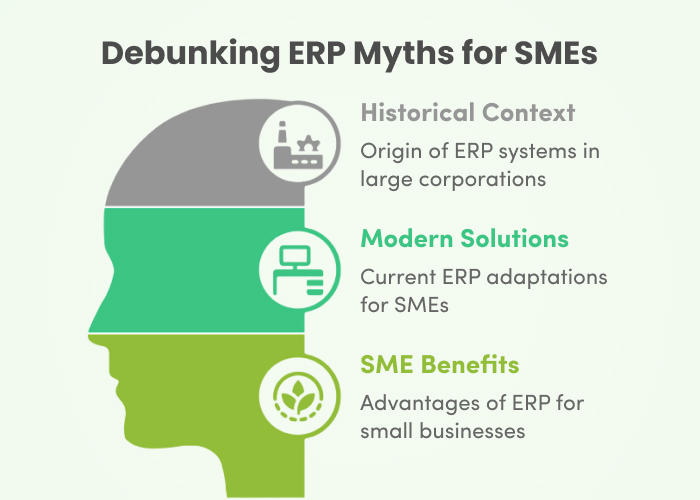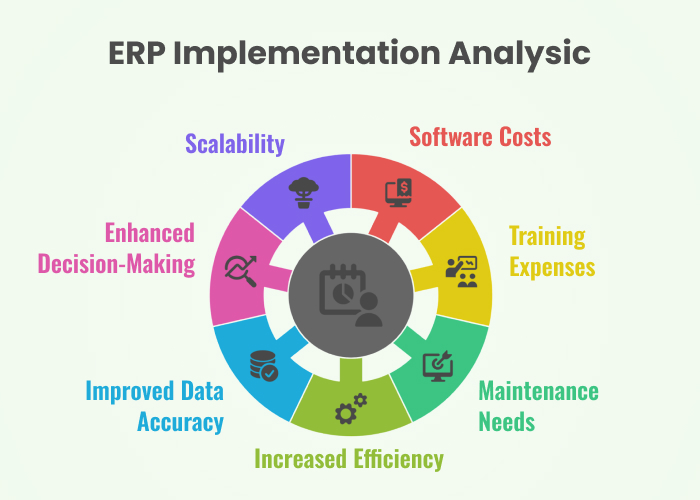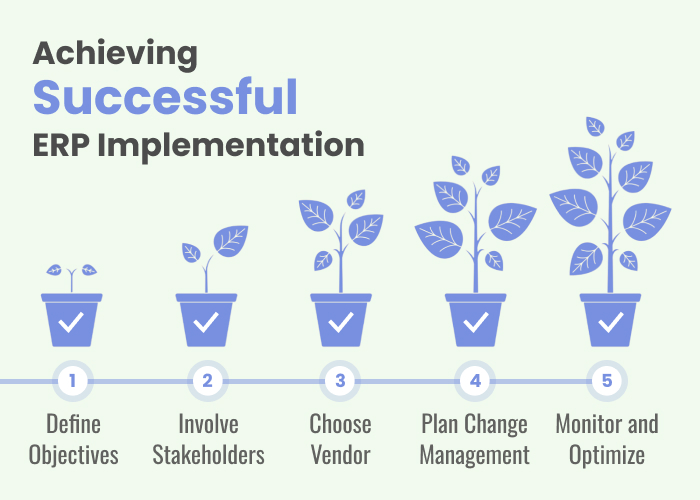Common Myths about ERP Being “Only for Large Enterprises”

Modern ERP solutions are now tailored to meet the needs of SMEs, offering scalable options that can grow alongside the business. These systems can provide SMEs with the same level of operational efficiency, data integration, and real-time insights that larger enterprises enjoy. By debunking this myth, SMEs can recognize that ERP is not just a luxury for the big players but a valuable tool that can drive growth and competitiveness.
Additionally, many SMEs hesitate to adopt ERP due to fears of high implementation costs and disruption to existing workflows. However, with the rise of modular ERP systems, businesses can start with essential features and expand as needed. These systems enhance efficiency, automate repetitive tasks, and improve collaboration by centralizing data, enabling SMEs to compete more effectively with larger enterprises.
By debunking this myth, SMEs can recognize that ERP is not just a luxury for the big players but a critical tool for optimizing operations, improving decision-making, and driving sustainable growth in an increasingly competitive market.
Cost-Benefit Analysis of Implementing ERP in Small and Mid-Sized Businesses

When considering the implementation of an ERP system, SMEs must conduct a thorough cost-benefit analysis. While the initial investment may seem daunting, the long-term benefits often outweigh the costs.
Costs:
- Software Licensing and Implementation Fees: Depending on the ERP vendor, these costs can vary significantly.
- Training and Change Management: Employees will need training to adapt to the new system, which can incur additional costs.
- Maintenance and Support: Ongoing support and system maintenance are essential for optimal performance.
Benefits:
- Increased Efficiency: ERP systems automate repetitive tasks, reducing manual errors and freeing up employee time for more strategic activities.
- Improved Data Accuracy: With a centralized database, SMEs can ensure that all departments have access to accurate and up-to-date information.
- Enhanced Decision-Making: Real-time analytics and reporting capabilities empower SMEs to make informed decisions quickly.
- Scalability: As the business grows, ERP systems can be scaled to accommodate increased operations without the need for a complete overhaul.
For SMEs looking to implement an ERP system, here are a few popular options providing robust solutions:
AlianHub – A modern ERP tailored for product and project management with AI-driven insights.
[ https://codecanyon.net/item/alianhub-project-management-system/51373823 ]
Jira – Widely used in agile development, Jira offers ERP capabilities through integrations and customization, making it a popular choice for software development firms.
[ https://www.atlassian.com/ ]
Odoo – A flexible open-source ERP with modules for CRM, inventory, and finance.
[ https://www.odoo.com/ ]
Ultimately, the cost-benefit analysis will vary based on the specific needs and goals of each SME, but many find that the investment pays off in the long run.
Case Studies of SMEs Leveraging ERP for Growth and Efficiency
Several SMEs have successfully implemented ERP systems, leading to significant improvements in their operations. Here are a couple of notable examples:
Case Study 1: A Software SME
Alian Software, a mid-sized software firm, faced challenges with fragmented tools, operational inefficiencies, and project delays. The absence of a centralized system led to miscommunications, resource mismanagement, and missed deadlines.
Implementing AlianHub ERP transformed their operations by providing:
Unified Project Management: Centralized dashboards offered comprehensive project overviews, enhancing planning and execution.
Enhanced Team Collaboration: Real-time chat and channels improved communication, reducing misunderstandings.
Automated Workflows: Automation features minimized manual tasks, boosting productivity.
Time Tracking and Reporting: Integrated tools provided insights into time allocation and project progress.
As a result, Alian Software reduced project delays by more than 80%, improved resource utilization, and achieved a 60% increase in operational efficiency. Leadership gained valuable insights, leading to a 90% improvement in project delivery timelines. Transitioning to AlianHub ERP enabled scalable growth and optimized operations.
Case Study 2: A Manufacturing SME
Betech is a specialist supplier of motors, gearboxes, and power transmission equipment for various industries. The company previously used Sage50 and Act CRM, which resulted in fragmented data and inefficient processes. In 2021, Betech implemented the Enapps ERP system, unifying their operations into a single platform. This integration improved inventory management, enhanced customer service, and streamlined processes across departments. As a result, Betech reinforced its commitment to delivering high-quality mechanical and electrical components with greater efficiency and accuracy.
These case studies illustrate how SMEs can leverage ERP systems to drive growth and enhance operational efficiency.
Best Practices for Seamless ERP Implementation

To ensure a successful ERP implementation, SMEs should follow these best practices:
- Define Clear Objectives: Establish specific goals for what the ERP system should achieve, such as improving efficiency or enhancing customer service.
- Involve Stakeholders: Engage employees from various departments in the decision-making process to ensure the system meets their needs.
- Choose the Right Vendor: Research and select an ERP vendor that specializes in solutions for SMEs and offers robust support.
- Plan for Change Management: Prepare employees for the transition by providing adequate training and resources to ease the adjustment period.
- Monitor and Optimize: After implementation, continuously monitor the system’s performance and make adjustments as necessary to maximize its benefits.
By adhering to these best practices, SMEs can navigate the complexities of ERP implementation and unlock the full potential of their investment.
Conclusion
In conclusion, ERP systems are not just for large enterprises; they are valuable tools that can significantly benefit small and medium-sized businesses. By dispelling common myths, conducting a thorough cost-benefit analysis, learning from successful case studies, and following best practices for implementation, SMEs can make informed decisions about investing in ERP solutions. Ultimately, the right ERP system can lead to enhanced efficiency, improved decision-making, and sustainable growth in an increasingly competitive marketplace.
Ravi Bhojani is the Chief Marketing Officer (CMO) at Alian Software, where he spearheads the company’s marketing strategies and drives its brand presence in the competitive IT services landscape. With over a decade of experience in the technology and marketing sectors, Ravi has consistently demonstrated his ability to blend innovative marketing techniques with deep industry knowledge to deliver outstanding results.